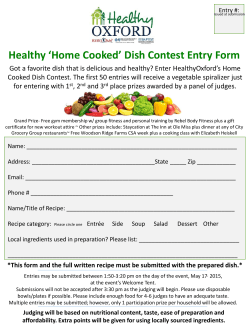
rules for the barbara petchenik children`s world map competition 2015
International Cartographic Association Commission on Cartography and Children RULES FOR THE BARBARA PETCHENIK CHILDREN'S WORLD MAP COMPETITION 2015 The Barbara Petchenik Award was created by the International Cartographic Association in 1993 as a memorial for Barbara Petchenik, a past Vice president of the ICA and cartographer who worked through her life with maps related to children. The aim of the contest is to promote the creative representation of the world in graphic form by children. The awards are given every two years during the ICA International Cartographic Conference, preferably at least one for each continent and only one award by country, with special consideration to the age of the child producing the drawing. The awarded drawings can be submitted to international organizations (UNICEF or other) for consideration as greeting cards or other publication. Participating nations are encouraged to report on the ways they have used for collecting drawing (video report, etc.) and to collect and archive maps for further research. OBJECTIVES OF THE COMPETITION The aims of the competition are to promote children’s creative representation of the world, to enhance their cartographic awareness and to make them more conscious of their environment. GENERAL RULES OF THE COMPETITION • ICA member nations will collect maps, on the theme “My place in today’s world”, produced by children under 16 years of age. This is the theme for the Barbara Petchenik Children's World Map Competition for the conferences in 2013 and 2015. • Non-ICA member nations cannot participate in the competition, but they can send entries to be displayed (out of the competition) in the International Exhibition. Entries from these nations have no right to obtain any prize from the Jury or visitors to the Exhibition. Entries are not returned to sending countries because they are collected and stored in the Carleton University Library in Ottawa, Canada. • The entries will be collected in four age groups: o under 6 years o 6-8 years o 9-12 years o above 12 years • An entry can be drawn by a maximum of three authors, all of them belonging to the same age group. If the number of authors is larger than three, then the entry is disqualified and separated from the competition. The international judging will focus on three criteria: 1) a recognizable message, 2) cartographic content, and 3) the quality of execution. In other words, judges will be looking for: 1. a recognizable connection between the form, shape, and use of cartographic elements which creatively address the Competition's theme. 2. a recognizable image of all or a large portion of the world in which the shapes and relative locations of land masses and oceans are as correct as can reasonably be expected for the child's age and within the context of the "system of projection" used. 3. appropriate cartographic elements such as symbols, colors, names and labels, etc., which help address the Competition's theme: - clarity and legibility of the point, line and area symbols appropriate to the media of expression, whether on paper or other surfaces, whether drawn or made up of indigenous materials. expressive rendering and appropriate use of the perceptual dimensions of color, i.e., changes in value for quantitative distinctions and changes in hue for qualitative distinctions. overall aesthetic quality in such matters as balance and harmony among the image elements. Parameters of the entries: 1. the maximum size must not exceed A3 (420 mm x 297 mm or 17 x 11 inches) 2. the surface should be flat and pasted-on objects may not be higher than 5 mm or 0.2 inch and have to be thoroughly fixed. 3. the map can be made using any unbreakable material (thus no glass). 4. no moveable or folding-out parts covering sections of the drawing (Note: the submissions will be photographed or scanned and the complete drawing has to be visible in one scan or photo). 5. no perishable materials (like leaves of plants) may be used. 6. do not plasticize or laminate the drawings because that disturbs the physical appearance of the drawing. • Any number of "systems of projection" can be used to generate the coastlines and other base material (e.g., international boundaries and graticule). The entry should be an original piece of work and it can be made using traditional methods (colour pencils, water colour, etc) or a computer program. • Each map must have the following information on a label attached to the back side of the representation: the name, age, school or personal address and country of its author and the title in either French or English (the ICA's official languages). If the entry is individual (not sent by a school) the author’s legal representatives (e.g. parents) will decide to make or not public their personal address. If the representatives do not agree to make it public, the official address of the ICA National Commission will be used for future contacts. • Parents of national winners (who have been selected to represent their countries in the International Exhibition) should sign an official ICA form agreeing to their children’s participation in the competition and the future use of their drawings for publication. • The winning entries will be submitted to international organizations (UNICEF International Art Committee or others), as well as to cartographic, GIS and other entities (e.g. ESRI) by the ICA Executive for consideration as greeting card designs, posters or other kind of publication that might best showcase the maps created for the Competition. ICA may use them as well. Any participant must agree that his/her representation may be reproduced by the ICA or other international organizations, or scanned for publication on the Internet by Carleton University (on behalf of the ICA) without consultation or copyright fees. • Competition maps will be archived in the Archives and Research Collections at Carleton University Library and will be available for public viewing on the Library’s website (see http://children.library.carleton.ca). SPECIFIC GUIDELINES FOR TEACHERS, PARENTS, ETC (TEACHER'S GUIDELINES FOR HANDLING THE COMPETITION) • A National Coordinator, who will be nominated by the national ICA member organisation for that country (see list at http://icaci.org/), will be responsible to provide all information needed by teachers interested in having their students participate in the competition. • Maps should be made following the general rules of the competition and the specific national rules determined by the National Coordinator. • All the entries should be submitted to the National Coordinator by the deadline specified in the Call for entries in the National Competition. • If a country has no National Coordinator, potential Competition entrants should contact the International Coordinator of the Competition and the Chair of the ICA Cartography and Children Commission (see http://icaci.org/commissions) before submitting an entry. • Submissions sent individually by schools, parents, etc without any previous contact with the International Coordinator of the Barbara Petchenik Competition and the Chair of the ICA Cartography and Children Commission will not be accepted and will not displayed or returned. INTERNATIONAL COORDINATOR’S GUIDELINES • The ICA Executive, consulting with Cartography and Children Commission Chair, will nominate an International Coordinator for the Competition. The International Coordinator’s tasks are: o To collect the entries submitted by the participating nations in the competition, checking if the submissions meet the requirements specified in the General rules. If the requirements are not met the International Coordinator will contact the National Coordinator to find a solution, consulting with Chair of the ICA Cartography and Children Commission. o To acknowledge by email the receipt of each country's submission. o To make a database of all submissions containing the data submitted with each drawing. o To scan or take digital photographs of the entries which will be used to make a website or CD-ROM containing submissions arranged by country and age group. The images must be accessible to the members of the International Judging Commission prior to the International Cartographic Conference (two months beforehand). o To safely convey the entries received from the participating nations to the address given by the Local Organizing Committee of the next International Cartographic Conference (1 month before the ICC). • All these activities will be supported financially by the ICA through the General Secretary/Treasurer, who sends a copy of the General Rules of the Competition to each National Coordinator approximately a year before the next contest. NATIONAL COORDINATOR'S GUIDELINES FOR HANDLING THE COMPETITION • Each ICA national member will nominate a coordinator to run the contest in his/her country. • The name of the coordinator must be received by the Secretary General, the Chair of Commission on Cartography and Children as well as the International Coordinator six to four months prior to the submission date of map entries. ICA member countries where no national coordinator is identified may participate provided that the ICA Executive receives the name of a country member willing to act as the coordinator for that country six to four months prior to the submission date of map entries. • Each national committee will select a maximum of six (6) maps, to be forwarded to the International Coordinator. For the purposes of the national competition, criteria other than those used for the international competition may be considered. • The National Coordinator is responsible for collecting the signed Parental Permissions of entries sent to the International Exhibition and to send them to the International Coordinator. • The maps selected by the national committees must be sent directly to the International Coordinator and not to the ICC Local Conference Committee. • When submitting the selected entries to the International Coordinator, national bodies are requested to include a letter which, for each submission, gives the following information: the name, age, school or authorized address and country of its author, the title in either French or English. • All entries sent to the International Coordinator must have a label attached to the verso of the representation which states the name, age, school or authorized address, country, and the title in either French or English. • The maps with the signed Parental Permissions and an accompanying letter should be sent so that it arrives by May 1, 2015 prior to the next ICA conference to the address of the International Coordinator of the Barbara Petchenik Competition. This address is also provided on the ICA website (http://icaci.org/) and Commission website (http://lazarus.elte.hu/ccc/ccc.htm): Peter van der Krogt / Ferjan Ormeling c/o Faculty of Geographic Sciences Utrecht University P.O. Box 80115 3508 TC Utrecht, The Netherlands Street address: c/o Faculty of Geographic Sciences Willem C. van Unnikgebouw, room 512 Heidelberglaan 2 3584 CS Utrecht, The Netherlands • All entries will be displayed during the next ICA conference as part of the International Map Exhibition that will be held as part of the 27th International Cartographic Conference of the International Cartographic Association in Rio de Janeiro, Brazil, 23-28 August, 2015. • National bodies will be responsible for distributing the certificates that will be subsequently awarded by the international Judging Commission. These certificates will be produced and provided by the Local Organizing Committee of the International Cartographic Conference. • The national coordinator and national ICA representatives can agree to the use of entries not awarded at national level of the competition by national organizations or institutions only for educational and research purposes, excepting cases of ICA sponsorship. The national coordinator is asked to send this information to the ICA Cartography and Children Commission Chairperson(s) to publish this information in the Commission website. • If a national coordinator or national ICA representative is contacted by an international organization, then ICA Executive Committee (President and/or Secretary General) and the Cartography and Children Commission Chairperson should be contacted before taking a decision. • Participating nations are encouraged to collect and archive all of the entries in their national competitions and to inform the Cartography and Children Commission (http://lazarus.elte.hu/ccc/ccc.htm) about their proposed methods for announcing the competition, establishing any additional judging criteria and the selection process used. This information will be of value in evaluating the success of the Competition and in making adjustments for future Competition operations. ICA JUDGING COMMISSION • Judging Commission is formed by eight (8) members (one Chair and seven members). Members of the Judging Commission can be selected from all those ICA Commissions which activities are related to Children, Education and Art. One or a maximum of two colleagues representing other international organizations related to children, education and cartography (IGU, UNICEF, other regional organizations, etc) can be also invited to be member of the Judging Commission. • Chairperson of the Judging Commission will be proposed by the ICA Cartography and Children Commission. When the nomination is approved by the representatives of ICA Executive Committee, both Chairpersons (Judging as well as Cartography and Children Commission Chair) can propose the other seven members of the Judging Commission to be also approved by representatives of the ICA Executive Committee. • Members cannot vote for entries from their own countries; st nd • Each Jury member may determine a 1 , 2 and 3 from 6 to 8, from 10 to 12 and above 12 years; rd place in each age group: under 6, A Jury member can nominate a maximum of two entries for a place, giving them the same number of points; • Each nominated drawing receives 5 points for 1 rd for 3 place; st place; 3 points for 2 nd place and 2 points • The sum of points received by a drawing determines its place within each age group: first st nd rd 3 drawings (1 , 2 and 3 ) in each age group receive ICA awards. Judging Commission has the right to declare empty a place in any age group or to give special mentions if members consider it necessary (e.g. special Jury award for the youngest participant). • This whole procedure will be completed before ICA conferences using e-mail between the Chair of the Judging Commission and its members; • The votes are summed by the Chair of the Judging Commission, who will send the results to all the members of the Judging Commission. • During the International Cartographic Conference the Chair and members of Judging Commission will personally meet in the Barbara Petchenik Exhibition, being responsible for making final decisions if needed, e.g. if the number of votes is the same for two maps, etc. • The Judging Commission can give only one prize to a country in any of the four age groups. This prize is apart from the public vote and a country can obtain both of them (a prize from the Judging Commission and the prize from the public vote). • Members of the Judging Commission will be introduced, the award-winning drawings displayed, and a summary of results will be announced during the Closing Ceremony of the ICC. This information will be published in the ICA News, as well as on the ICA and Commission websites. It will be sent to other international and regional organizations related to Geography, Cartography, Education, etc. in the interest of disseminating and making known the results of the competition. • The awards will be given to the national representatives during the Closing Ceremony. National representatives will present the awards to winners at a suitable occasion in their home country at an appropriate time after the conference. • The ICA Conference Organizing Committee is responsible in advertising a public vote on the Competition entries, which they should be allowed to do so provided that four conditions are met: 1. Members of the Judging Commission are responsible for counting the votes given by the visitors to the Barbara Petchenik International Exhibition. 2. Only one entry will be declared winner of the public vote in the four age groups; 3. the public vote will not be a criteria for or influence on the ICA judges as the voting public will likely have no knowledge or appreciation of the Competition rules and guidelines; 4. the voting slip design is adjudicated by the Cartography and Children Commission, on behalf of the ICA Executive Committee, so that its intent is clear; and 5. that the Local Organizing Committee be responsible for producing the Public Award certificate and to be responsible of notifying national participants to not voting on the entries coming from the Organizer country. • The results of the judging should normally be conveyed to the ICA Executive on the last day of the paper sessions at the ICC. The production of the awards certificates and their distribution to the appropriate national representatives is the responsibility of the Local Organizing Committee, represented by the Local Organizer of the Barbara Petchenik Exhibition, supported by the ICA Executive. Local Organizer receives from ICA Secretary General the amount in euros to be given together with the diplomas to the national representatives of winner entries. The national representatives are, in turn, responsible for conveying the certificates to the awardees. If an entry is awarded and there is no national representatives participating in the International Cartographic Conference, the Local Organizer and the Chair of Judging Commission should give the certificate and prize to the ICA Secretary General, who will send it for the winner after finishing the Conference. • The work of each national coordinator should be acknowledged by a letter from the ICA Executive. • Following the competition, all the national maps displayed at the ICC will be archived by the ICA. GUIDELINES FOR THE ORGANIZATION OF BARBARA PETCHENIK INTERNATIONAL EXHIBITION The Local Organizing Committee will exhibit the entries for the Barbara Petchenik contest either at the conference site or at the site where the map exhibition and technical exhibition are held. To this end: The Local Organizing Committee is responsible to name a Local Organizer of the exhibition The Local Organizing Committee will provide support needed to the Local Organizer, after entries are received from the International Coordinator and storing the same in appropriate conditions until the exhibition is mounted, including transportation of the entries to the exhibition venue The Local Organizer will instruct the technical staff to avoid the use of any kind of glue, adhesive tape, Velcro, etc directly onto the surface of the maps. Using a good quality drafting tape initially is recommended, which can later be peeled off without damage to the maps. Use of a drawing pin on the map corners is also acceptable. The Local Organizer, supported by the Local Organizing Committee, is responsible to find a quick solution to possible difficulties that can arise during the exhibition. The entries on the Exhibition stands should be organized by countries and each of them accompanied by the data related to each entry (title, author, age, school, country) printed in a readable size and displayed appropriately illuminated. Entries that have been disqualified or have been sent by non-ICA members nations should be displayed (out of the competition) in stands grouped at the end of the area dedicated to the International Exhibition, indicating clearly that those drawings are only exhibited and they are not elegible for voting. The Local Organizer, supported by the Local Organizing Committee, should assure diplomas are produced and awarded to children in all Competition categories. After the exhibition, the Local Organizer, supported by the Local Organizing Committee, will package and safely dispatch all entries as soon as possible to Carleton University Library at the following address: Attention: Sylvie Lafortune Head, Maps, Data and Government Information Centre MacOdrum Bldg. Carleton University Library 1125 Colonel By Drive, Ottawa, ON K1S 5B6 Canada WEB EXHIBITION IN THE MAPS, DATA AND GOVERNMENT INFORMATION CENTRE AT CARLETON UNIVERSITY LIBRARY, OTTAWA, CANADA All past competition entries can be viewed at http://children.library.carleton.ca
© Copyright 2025









